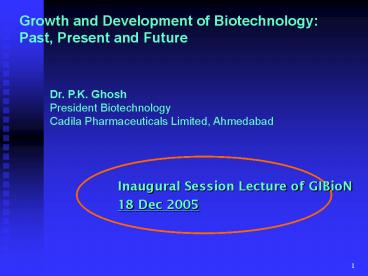Dr. P.K. Ghosh President Biotechnology - PowerPoint PPT Presentation
1 / 31
Title:
Dr. P.K. Ghosh President Biotechnology
Description:
Growth and Development of Biotechnology: Past, Present and Future Dr. P.K. Ghosh President Biotechnology Cadila Pharmaceuticals Limited, Ahmedabad – PowerPoint PPT presentation
Number of Views:164
Avg rating:3.0/5.0
Title: Dr. P.K. Ghosh President Biotechnology
1
Growth and Development of Biotechnology Past,
Present and Future
Dr. P.K. GhoshPresident Biotechnology Cadila
Pharmaceuticals Limited, Ahmedabad
Inaugural Session Lecture of GIBioN 18 Dec 2005
2
What is Biotechnology?
- Biotechnology techniques applied to organisms
or parts thereof to produce, identify or design
substances, or to modify organisms for specific
applications. - Cell fusion techniques, hybridomas, recombinant
DNA technology, cloning through whole genome
transfer, protein engineering, structure based
molecular design, genomics, proteomics, bio
informatics including biochips, cell therapy
including cell, tissue or organ transplant, xeno
- transplants or creation of artificial cells are
modern biotechnology. - Conventional biotechnology includes fermentation
or conversion of substrates into desired products
by biological processes use of microbes or
enzymes sera, vaccines and diagnostics
reproduction, artificial insemination and embryo
transfer technology for animal breeding methods
for fish spawning induction plant cell or tissue
culture plant breeding bio-fertilisers
bio-pesticides plant growth stimulants
extraction and isolation of active principles
from plants or animals or parts thereof etc.
3
Conventional Biotechnology Existed Since Ages!
4000 BC Egyptians used yeast for bread wine
making.
3000 BC Peruvians cultivated potatoes.
2000 BC Egyptians, Sumerians and Chinese
developed techniques of fermentation,
brewing and cheese making.
500 BC Chinese used moldy soybean curds to
treat boils.
Indian ancient literature (gt 4000 BC) refers to
Sura Madira which are fermented
beverages!
4
Beginning of Understanding Science of
Biotechnology
1590 Janssen invented the microscope.
1802 The terms biology first appeared in
literature.
1830 Proteins were discovered.
1860 Louis Pasteurs experiments abolished
the theory of spontaneous generation of
living organisms.
1865 Mendel discovered the existence of
heredity.
1897 Buchners discovered the biochemical
basis of life process.
1919 A Hungarian agricultural engineer coined
the term Biotechnology.
5
(No Transcript)
6
The Hershey-Chase Blender Experiment, 1952
No labeled sulphur detected in cells
Labeled Phosphorus detected in cells
LalLabeled sulphur detected in supernatant
No labeled phosphorus Detected in supernatant
7
Rosalind Franklins X-ray Diffraction Photo of
Structure B of DNA
Sodium deoxyribose nucleate from calf thymus,
Structure B, Photo 51, taken by Rosalind E.
Franklin and R.G. Gosling. Linus Pauling's
holographic annotations are to the right of the
photo., May 2, 1952.
8
DNA Double Helical Structure
9
Restriction Enzymes
10
Sangers Dideoxy Chain Termination Method for DNA
Sequencing
11
The Genetic Code
12
The Basic Constituents of lac Operon
13
The Central Dogma of Life
14
From Gene to Protein
15
Principle Of PCR
16
Gene Cloning (Recombinant DNA Technology)
17
Expression of Recombinant Proteins
- Recombinant proteins are expressed as
- 1) Intracellular Substances
- Insoluble protein
- Soluble protein
- Cytoplasmic
- Periplasmic
2) Extracellular Substances
18
Recombinant Protein Purification ISSUES
- Folding for activity
- Purity
Primary Techniques for purification
- Precipitation - pH and salt addition
- Ion exchange chromatography
- Hydrophobic interaction chromatography
- Gel filtration Chromatography
- Affinity Chromatography
19
Intracellular Insoluble Proteins as Inclusion
Bodies
Dense aggregates of mainly the desired protein
Concentration based
Unable to fold correctly in the environment
Cell lysis Enzyme treatment
Sonication French press
Dynomill Freeze-thaw
Simple purification steps using centrifugation
are used
20
Expression and Purity of Intracellularly
Expressed and Isolated Insoluble Proteins
1 2 3 4 5 6 7
8 9 10
- Mol. Wt marker
- Total cell no.1
- Inclusion Bodies no.1
- Total cell no. 2
- Inclusion Bodies no.2
- Total cell no.3
- Inclusion Bodes no.3
- Total cell no.4
- Inclusion Bodies no.4
68.0
43.0
29.0
20.0
14.3
Product obtained - insoluble and non-native
In-vitro refolding is essential
21
Intracellular Soluble Protein
Expressed protein is soluble
In-vitro refolding may not be required as protein
may attain native structure
Protein is extracted by simple lysis methods
Protein has large number of cellular protein
contaminants, compared with partially purified
inclusion bodies
22
Purification of a Soluble Cytoplasmic Protein
rp24 of HIV-1
23
Important Globally Approved Recombinant
Therapeutics
24
Important Globally Approved Genetically Modified
Plants
25
Microarray Technology
26
DOLLY- The Cloning Glory
27
Estimated Global Consumption of Modern Biotech
Products
28
Strategies for Technology Development In
Developing Country Industries
Environment Incountry Global, Influenced by
People, Politics, Government, etc.
A Developing Country Company
Alliances through Research Grants
Alliances through Institutions Companies
In-Country Abroad
Sponsored Research
Technology Sourcing Acquisitions
In-House RD
Technologies
Production Infrastructure
Products and Services Commercialization
29
Indian Strength in Biotechnology Development
- Capacity in handling sterile fermentation
processes - Skills in handling microbes and animal cells
- Skills in plant cell/tissue culture
- Competence in chemical synthesis, proficiency
in immunology and - hands-on experience in microbiology
- Capacity in downstream processing and isolation
methods - Skills in cloning
- Skills in extraction and isolation of plant
and animal products - Competence in plant and animal breeding
- Infrastructure and skills in fabricating
bio-reactors and processing - equipment of diverse kinds
30
Indias Entry Will Reduce Costs
- Health care products Hepatitis B Vaccine,
Interferon Alpha, - Erythropoietin and Insulin doses cost less.
- Agriculture Genetically modified planting
materials will be - available at cheaper prices.
- Prices of Industrial products like Enzymes
will also come - down.
31
Concluding Remarks
- Modern Biotechnology has made tremendous progress
during the last 5 decades. - The number of Biotech products are increasing at
a galloping speed in Health care area,
Agriculture and Industrial applications. - Industries in Developed Countries shall hold
Major Technologies. - Developing countries incl. India shall also make
progress. - All Biotech Industries shall need strong support
from Governments. - Indian development would contribute to providing
Biotech products at cheaper prices though total
contribution in global context would be small. - Skilled Biotechnologists would have plenty of
opportunities































